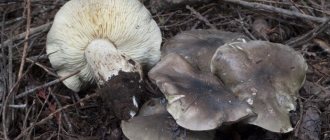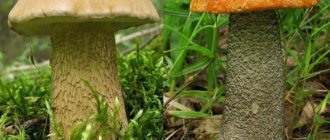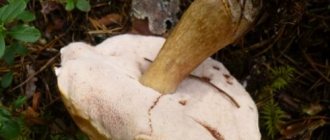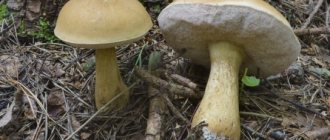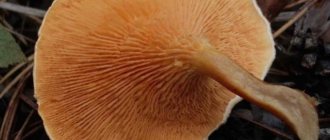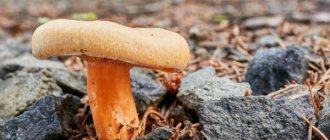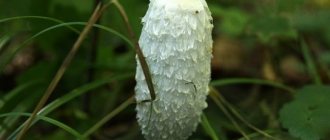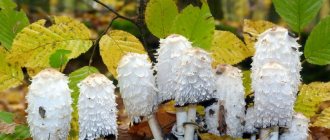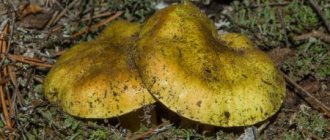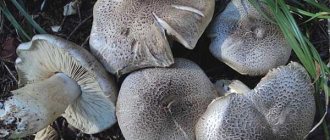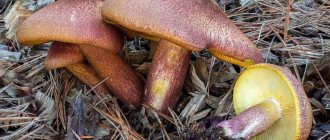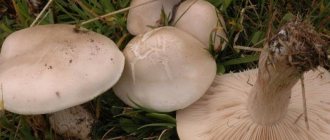Mushrooms
0
1518
Article rating
Kira Stoletova
Among the little-known mushrooms in Russia and Europe, the white-brown row is found. It grows in groups in coniferous forests and pine forests. The mushroom is considered late. It is collected from August to the 2nd half of October.
Description of the white-brown row mushroom
Where does the brown row mushroom grow and what does it look like?
The cap is approximately four to eight centimeters wide, at the start of growth it is convex, with curled edges, then it becomes more spread-convex. The color varies from brown to brownish brown, becoming slightly lighter towards the edges. The plates are densely distributed, wide, sprouted with uniform projections, at the start of growth they have a milky tint, then they become more creamy, brownish, with spots similar to rust.
The leg reaches 6–8 cm, elongated upward, often curved, becomes wider closer to the base, becomes more hollow with age, light or milky at the top, slightly brownish or purple below. The pulp is dense, milky in color, and has a light aroma. The rower lives in pine forests. It grows in families near roads and in places where there is light.
Marinating rules
It is allowed to marinate tricholomas at home only after complete (long) soaking and further heat treatment. Only then will the rows bring real benefits and become a glorious decoration of the family table.
The algorithm for preliminary preparation of rows is as follows:
- Completely clear of soil and leaves.
- Trim the bottom of the leg (this part is not suitable for eating).
- Rinse the rows thoroughly with running water.
- Sort: small ones can be marinated completely, and large ones can be cut into pieces for marinating.
- Place all the fruits in a large container and fill completely with cool water.
- Leave the rows to soak for up to 2-3 days in a dark place with a low temperature.
- Then the mushrooms are washed and cleaned (the skin should be removed from the cap).
- The prepared tricholomas are poured with clean salted water (5-7 g of salt per liter of water) and placed on the stove.
- Boil for 30-40 minutes (the foam is removed).
- When the rows are at the bottom of the pan, the broth is drained and the mushrooms are washed with water again.
Before marinating, place sterilized containers with lids and marinade nearby (its preparation depends on the recipe).
Varieties of brown rowing
Brown row is a general name for several categories: white-brown and white-brown, sweet, lashanka, poplar and green. Their shapes and appearance vary due to the influence of their habitats. There are two main subspecies in this category - white-brown and chestnut-brown.
Did you know? Scientists have confirmed that mushrooms lived before dinosaurs. More than 400 million years ago.
White-brown row
The width of the cap is 4–10 cm. At the start of its growth, the cap is roundish with curled edges. Then it becomes more flattened. The skin is smooth, with occasional small cracks visible. After rain it may feel a little sticky to the touch. Has a brownish tint. Towards the edges the cap becomes lighter to pure white. The pulp inside is dense and has a neutral aroma.
The plates are densely distributed . White color. The edges are abrupt. The size of the leg is up to 10 cm. The lower it is to the base, the thicker the leg is and has a milky tint. Only at the point of attachment of the plates does it become more brownish. It grows in pine and mixed forests. The growth period is from August to November.
Row chestnut brown
Another name is Gorchakov or broken. Their fruiting body is massive and fragrant. The cap is convex, after a certain period of time it becomes quite prostrate. It reaches up to 15 cm in circumference. The upper part of the fruiting body has a red-chestnut color, but occasionally it can take on a yellowish tint. The cap is smooth to the touch. There is a depression in the center and small cracks on the edges.
Leg: no more than 3 cm in circumference, approximately 5–13 cm long, voluminous and dense, similar to a cylinder, becoming thinner towards the base of the mushroom. On the stem there is a white ring with a powdery coating. The pulp is also white in color, but at the cut site it gives off redness and emits a sweet and sour aroma. It usually lives in pine forests, the soil of which is more fertile and the areas are covered with moss. It grows in groups from September to March.
Similar species
The brown row mushroom is harmless. But if you don’t know its distinctive features well enough, you can easily confuse the specimen with other similar and sometimes dangerous types of rowing.
- Yellow-brown. It has yellow flesh and yellow-brown plates. The fungus forms mycorrhiza with birch. This specimen cannot be found in coniferous forests. It belongs to the edible and safe representatives of the kingdom, but at the same time, it is considered very tasteless. Avid mushroom pickers never collect it.
- Spotted. If stains are found on the cap, you need to be wary. The specimen is classified as low-poisonous, but at the same time poses a danger to humans. The spots are arranged in circles or dark and wide stripes. The pulp is bitter. It grows both singly and in families. It can be extremely difficult to distinguish a mushroom from the original. The main difference is the absence of a clear color transition on the stem. Also, the characteristic bitterness of the pulp should cause suspicion.
- Broken. The main difference is a thin, film-like ring that is slimy to the touch. It is located under the cap. You need to focus on the place where the brown shade of the leg turns into light. The taste of the pulp is bitter, but the specimen is safe and can be used as food.
- Poplar. It does not grow in forests - this is the main difference from the original mushroom. In appearance, the mushroom is larger and fleshier. The specimen is safe and is used in cooking quite often.
- Golden. It has a bright golden-orange hue. The entire area is covered with small scales. Edibility is very conditional. According to some reports, it contains a strong poison similar to muscarine. It belongs to the conditionally edible specimens, but is not valued by mushroom pickers.
Carefully inspect all collected mushrooms. Don’t be greedy and feel free to get rid of suspicious specimens.
Chemical composition
The rows contain vitamins B, A, C, D2, D7, K, PP, and betaine. They contain minerals such as phosphorus, iron, sodium, potassium, zinc, manganese. Amino acids - aliphatic, phenylpropionic, hydroxyamino acid, diaminohexanoic, aspartic, aminopentanedioic and octadecanoic acids. They also contain natural antibiotics. These are clitocin and fomecin, they counteract bacteria and cancer cells.
Edibility
The white-brown row is conditionally edible due to the presence of bitterness. Fruit bodies cause poisoning in the absence or insufficient time of heat treatment.
Attention! The degree of maturity of this tricholoma also affects edibility. The younger the mushroom, the safer it is.
Irina Selyutina (Biologist):
Different sources give different information about the edibility of the white-brown row. Some call it an edible mushroom, others classify it as conditionally edible or even classify it as an inedible species. Officially, the white-brown row is classified as a conditionally edible mushroom and belongs to category 4 in terms of taste. In this regard, it requires preliminary long-term boiling. If the heat treatment time is short, lashanka can cause mild poisoning. Therefore, for safety, it is better to take only young specimens into the basket, but large adult specimens should be left in the forest.
The edible row has a slightly poisonous counterpart - the spotted row. It is recognized by dark spots on its cap. The inclusions are located around the circumference or cross the diameter of the cap.
A dangerous species is recognized by the absence of a tubercle in the center of the cap and a pronounced bitter taste.
Useful properties of the mushroom
Row mushrooms stimulate the digestive tract. Favors the restoration of liver cells and getting rid of harmful substances that accumulate in the body. Mushrooms of this type are excellent for fighting bacteria, inflammation, viruses, and oxidizing agents that disrupt the functioning of the body.
- Rows have a beneficial effect on the treatment of diseases such as:
- diabetes;
- uneven blood pressure during contraction of the ventricles of the heart;
- accelerated heartbeat;
- Sokolsky-Buyo disease;
- osteoporosis;
- diseases of the nervous system;
- bladder and kidney diseases;
- oncological diseases.
Collection rules
In order to ensure that only edible rows end up in the mushroom picker’s basket, you should remember the following collection rules:
- It is important to clearly know the characteristics and description of the appearance of the mushroom that needs to be collected.
- There are dangerous poisonous doubles; they are distinguished by the presence of a small tubercle in the middle of the cap, as well as a characteristic thin stalk.
- Mushrooms cannot be picked, only cut with a knife. This is necessary in order not to damage the mycelium and next year to get a harvest in the same place.
It is worth remembering that the shelf life of raw mushrooms is not too long - up to 7 days in the refrigerator, so you need to collect exactly the amount that will later be consumed.
Use in cooking
The mushroom does not look very pretty, but at the same time it has a unique taste. Therefore, it is often used in cooking. You can cook mushrooms of any age, even if they were collected after frost. The rows are fried, pickled, stewed, dried. You can use them as an addition in the form of sauces when preparing casseroles and soups. Mushrooms go well with meat dishes, adding piquancy to them.
Important! Before you start cooking, the rows need to be soaked in cold water for several hours, peeled and boiled for 20 minutes. This will help get rid of bitterness.
Interesting Facts
Growing rows is often carried out according to the principle of growing champignons; they grow easily and are often used for sale for export.
Cosmetologists also use lashankas to create ointments and creams; most often they are used to create remedies for acne or excess skin greasiness.
Ryadovka is a good conditionally edible mushroom. It is especially popular in those years when there are few more delicious mushrooms. It grows in large groups, which means it can be collected quickly and in large quantities. The preparation is not complicated, just boil it well and you can eat it. And if you want, then you should try growing it at home.
Application in medicine
Brown grass has a beneficial effect on the immune system, speeds up metabolism, which helps remove cholesterol and toxins from the body. As a result, excess weight is lost and the functioning of all human systems and organs is improved. Tinctures and extracts are made from the rows, which are used for diseases of the organs: liver and kidneys.
Benefit
The properties of the brown row mushroom are varied. It improves the resistance of the immune system, removes toxins and cholesterol, and helps speed up metabolism. That is why the specimen often forms the basis of dietary nutrition for those who are trying to lose weight or normalize the functioning of internal organs.
Rowberry extract is used in the treatment of diseases of the urinary system and liver. It actively restores cells.
The product, prepared in compliance with all technologies, remains useful and does not lose its properties. It contains:
- Magnesium.
- Vitamins A, B1, B12, C, D.
- Amino acids.
Also, representatives of the brown row contain a lot of protein (about 5%). But at the same time it is easily digestible. The calorie content of the product depends on the cooking method. The average number of calories is 32 per 100 grams.
Possible harm from the mushroom
Row mushrooms accumulate wastes that come from the atmosphere, as well as heavy metals. In view of this, overripe mushrooms that grow along highways and near large cities will most likely not be useful, but rather harm the body. If you overeat, there may be excessive accumulation of gases in the intestines, pain and heaviness in the abdomen. It is harmful to overeat mushrooms for people with low acidity, inflammation of the stomach walls, contractility disorder and inflammation of the gallbladder and pancreas.
If you feel unwell after eating mushrooms, call a doctor immediately.
Brown row - when used correctly, can have a positive effect on body functions. Its healing properties have long been proven and tested. The mushroom is successfully used both as a medicinal remedy and in cooking. Despite its bitter taste, rows are an ingredient in many recipes. But do not forget about the dangers and restrictions associated with the use of these mushrooms.
Important Tips
Poplar row.
Inexperienced mushroom pickers who go hunting for mushrooms are better off joining the company of more experienced people.
When collecting, consider the following tips:
- If you doubt the edibility of the rows, it is better not to take them.
- Do not collect old and already spoiled fruits.
- For containers, use a wicker basket with access to air masses.
- For large tricholomas, immediately cut off the cap and place tubular fruits with the stem down.
- Clear the soil from the rows immediately, do not leave it.
If the weather has treated you to a long dry period, then there is no point in going for a mushroom harvest. Hunting for rowers will be successful after heavy rain.
Growing
The white-brown row is cultivated similarly to champignons.
Description of the basic rules of cultivation:
- the crop is sown in early May or autumn;
- regardless of the method of cultivation, it is imperative to carry out cultivation, which improves the aeration of the mycelium;
- the mycelium develops at 20°C or more, but the fruiting bodies begin to grow at temperatures below 15°C, so the temperature regime must be maintained.
Open ground
The mycelium is laid in the garden in beds. Choose a shaded place, under a canopy that protects from rain and direct sunlight.
Soil taken under pine trees is suitable. The soil is mixed with mycelium and planted. Immediately cover the soil, thereby providing high humidity.
After 20-28 days, mycelium grows on the ground. It is covered with damp soil 4-5 cm thick and constantly moistened. After 15-20 days, the first fruiting bodies of the crop are formed.
When the air temperature drops to 5°C and below, the soil is covered with dense material. Dry leaves with straw are placed on it.
